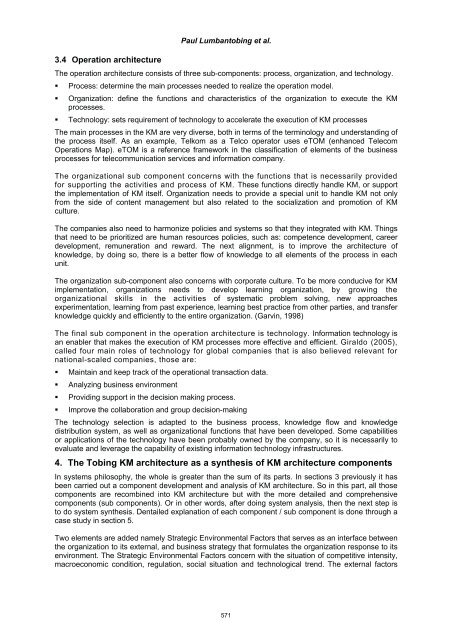Proceedings of the 3rd European Conference on Intellectual Capital
Proceedings of the 3rd European Conference on Intellectual Capital
Proceedings of the 3rd European Conference on Intellectual Capital
You also want an ePaper? Increase the reach of your titles
YUMPU automatically turns print PDFs into web optimized ePapers that Google loves.
3.4 Operati<strong>on</strong> architecture<br />
Paul Lumbantobing et al.<br />
The operati<strong>on</strong> architecture c<strong>on</strong>sists <str<strong>on</strong>g>of</str<strong>on</strong>g> three sub-comp<strong>on</strong>ents: process, organizati<strong>on</strong>, and technology.<br />
Process: determine <str<strong>on</strong>g>the</str<strong>on</strong>g> main processes needed to realize <str<strong>on</strong>g>the</str<strong>on</strong>g> operati<strong>on</strong> model.<br />
Organizati<strong>on</strong>: define <str<strong>on</strong>g>the</str<strong>on</strong>g> functi<strong>on</strong>s and characteristics <str<strong>on</strong>g>of</str<strong>on</strong>g> <str<strong>on</strong>g>the</str<strong>on</strong>g> organizati<strong>on</strong> to execute <str<strong>on</strong>g>the</str<strong>on</strong>g> KM<br />
processes.<br />
Technology: sets requirement <str<strong>on</strong>g>of</str<strong>on</strong>g> technology to accelerate <str<strong>on</strong>g>the</str<strong>on</strong>g> executi<strong>on</strong> <str<strong>on</strong>g>of</str<strong>on</strong>g> KM processes<br />
The main processes in <str<strong>on</strong>g>the</str<strong>on</strong>g> KM are very diverse, both in terms <str<strong>on</strong>g>of</str<strong>on</strong>g> <str<strong>on</strong>g>the</str<strong>on</strong>g> terminology and understanding <str<strong>on</strong>g>of</str<strong>on</strong>g><br />
<str<strong>on</strong>g>the</str<strong>on</strong>g> process itself. As an example, Telkom as a Telco operator uses eTOM (enhanced Telecom<br />
Operati<strong>on</strong>s Map). eTOM is a reference framework in <str<strong>on</strong>g>the</str<strong>on</strong>g> classificati<strong>on</strong> <str<strong>on</strong>g>of</str<strong>on</strong>g> elements <str<strong>on</strong>g>of</str<strong>on</strong>g> <str<strong>on</strong>g>the</str<strong>on</strong>g> business<br />
processes for telecommunicati<strong>on</strong> services and informati<strong>on</strong> company.<br />
The organizati<strong>on</strong>al sub comp<strong>on</strong>ent c<strong>on</strong>cerns with <str<strong>on</strong>g>the</str<strong>on</strong>g> functi<strong>on</strong>s that is necessarily provided<br />
for supporting <str<strong>on</strong>g>the</str<strong>on</strong>g> activities and process <str<strong>on</strong>g>of</str<strong>on</strong>g> KM. These functi<strong>on</strong>s directly handle KM, or support<br />
<str<strong>on</strong>g>the</str<strong>on</strong>g> implementati<strong>on</strong> <str<strong>on</strong>g>of</str<strong>on</strong>g> KM itself. Organizati<strong>on</strong> needs to provide a special unit to handle KM not <strong>on</strong>ly<br />
from <str<strong>on</strong>g>the</str<strong>on</strong>g> side <str<strong>on</strong>g>of</str<strong>on</strong>g> c<strong>on</strong>tent management but also related to <str<strong>on</strong>g>the</str<strong>on</strong>g> socializati<strong>on</strong> and promoti<strong>on</strong> <str<strong>on</strong>g>of</str<strong>on</strong>g> KM<br />
culture.<br />
The companies also need to harm<strong>on</strong>ize policies and systems so that <str<strong>on</strong>g>the</str<strong>on</strong>g>y integrated with KM. Things<br />
that need to be prioritized are human resources policies, such as: competence development, career<br />
development, remunerati<strong>on</strong> and reward. The next alignment, is to improve <str<strong>on</strong>g>the</str<strong>on</strong>g> architecture <str<strong>on</strong>g>of</str<strong>on</strong>g><br />
knowledge, by doing so, <str<strong>on</strong>g>the</str<strong>on</strong>g>re is a better flow <str<strong>on</strong>g>of</str<strong>on</strong>g> knowledge to all elements <str<strong>on</strong>g>of</str<strong>on</strong>g> <str<strong>on</strong>g>the</str<strong>on</strong>g> process in each<br />
unit.<br />
The organizati<strong>on</strong> sub-comp<strong>on</strong>ent also c<strong>on</strong>cerns with corporate culture. To be more c<strong>on</strong>ducive for KM<br />
implementati<strong>on</strong>, organizati<strong>on</strong>s needs to develop learning organizati<strong>on</strong>, by growing <str<strong>on</strong>g>the</str<strong>on</strong>g><br />
organizati<strong>on</strong>al skills in <str<strong>on</strong>g>the</str<strong>on</strong>g> activities <str<strong>on</strong>g>of</str<strong>on</strong>g> systematic problem solving, new approaches<br />
experimentati<strong>on</strong>, learning from past experience, learning best practice from o<str<strong>on</strong>g>the</str<strong>on</strong>g>r parties, and transfer<br />
knowledge quickly and efficiently to <str<strong>on</strong>g>the</str<strong>on</strong>g> entire organizati<strong>on</strong>. (Garvin, 1998)<br />
The final sub comp<strong>on</strong>ent in <str<strong>on</strong>g>the</str<strong>on</strong>g> operati<strong>on</strong> architecture is technology. Informati<strong>on</strong> technology is<br />
an enabler that makes <str<strong>on</strong>g>the</str<strong>on</strong>g> executi<strong>on</strong> <str<strong>on</strong>g>of</str<strong>on</strong>g> KM processes more effective and efficient. Giraldo (2005),<br />
called four main roles <str<strong>on</strong>g>of</str<strong>on</strong>g> technology for global companies that is also believed relevant for<br />
nati<strong>on</strong>al-scaled companies, those are:<br />
Maintain and keep track <str<strong>on</strong>g>of</str<strong>on</strong>g> <str<strong>on</strong>g>the</str<strong>on</strong>g> operati<strong>on</strong>al transacti<strong>on</strong> data.<br />
Analyzing business envir<strong>on</strong>ment<br />
Providing support in <str<strong>on</strong>g>the</str<strong>on</strong>g> decisi<strong>on</strong> making process.<br />
Improve <str<strong>on</strong>g>the</str<strong>on</strong>g> collaborati<strong>on</strong> and group decisi<strong>on</strong>-making<br />
The technology selecti<strong>on</strong> is adapted to <str<strong>on</strong>g>the</str<strong>on</strong>g> business process, knowledge flow and knowledge<br />
distributi<strong>on</strong> system, as well as organizati<strong>on</strong>al functi<strong>on</strong>s that have been developed. Some capabilities<br />
or applicati<strong>on</strong>s <str<strong>on</strong>g>of</str<strong>on</strong>g> <str<strong>on</strong>g>the</str<strong>on</strong>g> technology have been probably owned by <str<strong>on</strong>g>the</str<strong>on</strong>g> company, so it is necessarily to<br />
evaluate and leverage <str<strong>on</strong>g>the</str<strong>on</strong>g> capability <str<strong>on</strong>g>of</str<strong>on</strong>g> existing informati<strong>on</strong> technology infrastructures.<br />
4. The Tobing KM architecture as a syn<str<strong>on</strong>g>the</str<strong>on</strong>g>sis <str<strong>on</strong>g>of</str<strong>on</strong>g> KM architecture comp<strong>on</strong>ents<br />
In systems philosophy, <str<strong>on</strong>g>the</str<strong>on</strong>g> whole is greater than <str<strong>on</strong>g>the</str<strong>on</strong>g> sum <str<strong>on</strong>g>of</str<strong>on</strong>g> its parts. In secti<strong>on</strong>s 3 previously it has<br />
been carried out a comp<strong>on</strong>ent development and analysis <str<strong>on</strong>g>of</str<strong>on</strong>g> KM architecture. So in this part, all those<br />
comp<strong>on</strong>ents are recombined into KM architecture but with <str<strong>on</strong>g>the</str<strong>on</strong>g> more detailed and comprehensive<br />
comp<strong>on</strong>ents (sub comp<strong>on</strong>ents). Or in o<str<strong>on</strong>g>the</str<strong>on</strong>g>r words, after doing system analysis, <str<strong>on</strong>g>the</str<strong>on</strong>g>n <str<strong>on</strong>g>the</str<strong>on</strong>g> next step is<br />
to do system syn<str<strong>on</strong>g>the</str<strong>on</strong>g>sis. Dentailed explanati<strong>on</strong> <str<strong>on</strong>g>of</str<strong>on</strong>g> each comp<strong>on</strong>ent / sub comp<strong>on</strong>ent is d<strong>on</strong>e through a<br />
case study in secti<strong>on</strong> 5.<br />
Two elements are added namely Strategic Envir<strong>on</strong>mental Factors that serves as an interface between<br />
<str<strong>on</strong>g>the</str<strong>on</strong>g> organizati<strong>on</strong> to its external, and business strategy that formulates <str<strong>on</strong>g>the</str<strong>on</strong>g> organizati<strong>on</strong> resp<strong>on</strong>se to its<br />
envir<strong>on</strong>ment. The Strategic Envir<strong>on</strong>mental Factors c<strong>on</strong>cern with <str<strong>on</strong>g>the</str<strong>on</strong>g> situati<strong>on</strong> <str<strong>on</strong>g>of</str<strong>on</strong>g> competitive intensity,<br />
macroec<strong>on</strong>omic c<strong>on</strong>diti<strong>on</strong>, regulati<strong>on</strong>, social situati<strong>on</strong> and technological trend. The external factors<br />
571
















